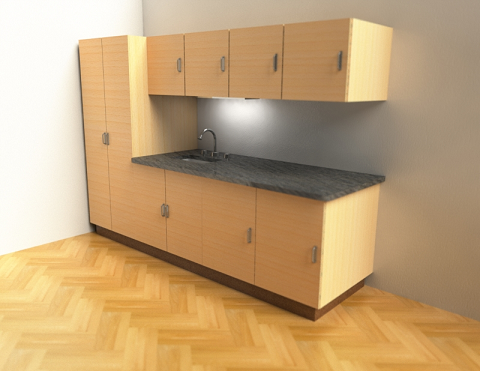Many designers in the woodworking industry are traditionally accustomed to
working with 2D CAD tools. One of the recent driving forces to move to 3D
comes with the availability of simple, easy to use photo rendering tools that
can produce high-quality images for marketing or project proposals. SOLIDWORKS
Professional includes such rendering capabilities, used to render the image
below.
 |
Other reasons for investigating a move to 3D CAD may be to take advantage of
integrated CAM solutions such as CAMWorks to take advantage of the automated
generation of toolpath for equipment such as CNC routers.
This article and companion video is intended to give an overview of some of
the capabilities of SOLIDWORKS useful for cabinetry and the woodworking
industry and will describe the design of a set of frameless cabinets.
The design of this set of frameless cabinets below was kicked off by a simple
2D layout elevation plan sketch. The individual cabinets are modular units
that can be configured with a variety of doors and hardware.
The cabinets can be linked to the top level elevation plan sketch in such a
way that dynamic adjustments can be made to the layout that will update
cabinets, following rules and logic built into the model, such as to maintain
particular hole and shelf spacing. This is known as “top-down” modeling in
SOLIDWORKS and is particularly useful for users doing many “similar but
different” orders for custom made-to-order units.
 |
Alternatively, SOLIDWORKS configurations can be used to create many variants
of a single cabinet to fulfill a wide variety of use cases. This is useful for
companies that have standardized products that are produced in higher quantity
and would be known as “bottom-up” modeling in SOLIDWORKS.
There is intelligence built into the pattern for the shelves shown below to
automatically maintain a specified spacing, and add more shelves as needed.
Equations or Design Tables can be used in SOLIDWORKS to add even more control
and logic.
 |
Another functionality of note is the ability to import Existing 2D DXF/DWG
files. This can be used to collaborate with architects/designers providing 2D
layouts and floorplans, or to rebuild legacy parts in 3D.
Additionally, SOLIDWORKS features strong 2D drawing creation tools, along with
the ability to export 2D drawings to DWG/DXF and maintain control over
properties such as layers and line weights.
A follow-up article will focus on framed cabinet construction and additional
details.
For more information, check out our
YouTube channel
or contact us at
Hawk Ridge Systems
today. Thanks for reading!




